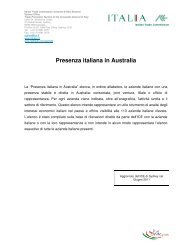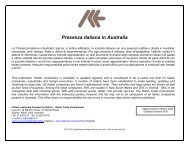Price Determination in the Australian Food Industry A Report
Price Determination in the Australian Food Industry A Report
Price Determination in the Australian Food Industry A Report
Create successful ePaper yourself
Turn your PDF publications into a flip-book with our unique Google optimized e-Paper software.
Figure 91. Share of retail price of margar<strong>in</strong>e, 500g tub, average across category<br />
%<br />
100<br />
80<br />
60<br />
retail<br />
wholesale/marketer<br />
primary processor<br />
farmgate<br />
40<br />
20<br />
0<br />
Source: <strong>Industry</strong> sources<br />
The amount represented by <strong>the</strong> retail sector reflects marg<strong>in</strong> and any costs <strong>the</strong>y have <strong>in</strong> centralised<br />
warehous<strong>in</strong>g and adm<strong>in</strong>istration. Marg<strong>in</strong>s for <strong>the</strong> retail sector are estimated to be 35 per cent of<br />
<strong>the</strong> wholesale price. In <strong>the</strong> wholesale sector, <strong>the</strong>re are marg<strong>in</strong>s for both <strong>the</strong> crusher and ref<strong>in</strong>er.<br />
The ref<strong>in</strong>er is recover<strong>in</strong>g full overheads and marg<strong>in</strong> <strong>in</strong> this segment, although marg<strong>in</strong>s vary<br />
significantly between branded and private label product. Marg<strong>in</strong>s on private label product are<br />
estimated to be around 10 per cent or less while <strong>the</strong>y could be double this on branded product.<br />
The <strong>in</strong>creas<strong>in</strong>g share be<strong>in</strong>g won by private labels is putt<strong>in</strong>g pressure on <strong>the</strong> ref<strong>in</strong>ers’ marg<strong>in</strong>s as<br />
<strong>the</strong>re is little opportunity to differentiate product based on quality and competition is purely based<br />
on price.<br />
Drivers of cost<br />
The major factor caus<strong>in</strong>g variation <strong>in</strong> <strong>the</strong> cost base from year to year is <strong>the</strong> price of canola seed.<br />
This is largely determ<strong>in</strong>ed by <strong>the</strong> size of <strong>the</strong> domestic and <strong>in</strong>ternational crop. The major cost <strong>in</strong> <strong>the</strong><br />
production of cook<strong>in</strong>g oil and margar<strong>in</strong>e is <strong>the</strong> raw material – approximately 60 per cent of <strong>the</strong><br />
wholesale price and similar at <strong>the</strong> crusher door. The <strong>in</strong>dustry’s cost base has been relatively static<br />
for <strong>the</strong> past four to five years.<br />
Canola is viewed as premium oil on world markets, where soy and palm oil are <strong>the</strong> low-cost<br />
commodity oils. However, <strong>in</strong> Australia, where <strong>the</strong>re is little production of soybeans and no palm oil<br />
production, canola is <strong>the</strong> core of <strong>the</strong> <strong>in</strong>dustry. As <strong>the</strong> <strong>in</strong>dustry has grown and with 75 per cent of<br />
<strong>the</strong> crop exported <strong>the</strong> ref<strong>in</strong>ers are look<strong>in</strong>g to purchase oil priced from export parity for seed ra<strong>the</strong>r<br />
than import parity.<br />
The cost breakup for <strong>the</strong> sector is shown below.<br />
Figure 92. Cost dissection for cook<strong>in</strong>g oil products<br />
raw materials and<br />
process<strong>in</strong>g<br />
31%<br />
packag<strong>in</strong>g 8%<br />
warehous<strong>in</strong>g, distribution 6%<br />
Source: <strong>Industry</strong> sources<br />
market<strong>in</strong>g,<br />
adm<strong>in</strong>istration,<br />
overheads, etc<br />
55%<br />
The raw material cost is <strong>the</strong> cost <strong>in</strong>to <strong>the</strong> ref<strong>in</strong>ery. The equation is complex because at <strong>the</strong> crush<br />
level <strong>the</strong> crusher processes seed to produce oil and meal. The relative contribution of oil and meal<br />
to <strong>the</strong> crush<strong>in</strong>g return is driven by <strong>the</strong> relative prices for oil and meal and this relationship varies<br />
between years and with<strong>in</strong> a year.<br />
<strong>Price</strong> <strong>Determ<strong>in</strong>ation</strong> <strong>in</strong> <strong>the</strong> <strong>Australian</strong> <strong>Food</strong> <strong>Industry</strong> A <strong>Report</strong><br />
85







